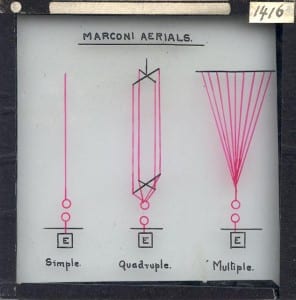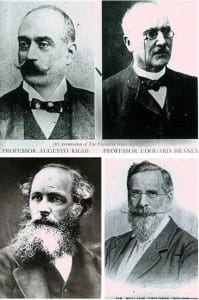Re-packing UCL´s Magic Lantern Slides
By uclqmbr, on 29 July 2014
As my time working with UCL’s lantern slides draws to a close, I thought I’d reflect on some of the things I’ve discovered over the past few weeks. (To learn what lantern slides are, and why UCL has accumulated thousands of them, click here).
The majority of the slides in the UCL Science and Engineering collection are, unsurprisingly enough, about Engineering. Electrical Engineering to be precise. I must say that, having not had a single Physics lesson in the past six years, the prospect of cataloguing slide after slide of what looked like identical electric circuits was not exactly my cup of academic tea. But I soon learnt that there is a lot more to ElecEng (as it is apparently abbreviated) than alternators, resonators, oscillators and commutators. In particular, I became interested in UCL’s very own Sir John Ambrose Fleming, founder of England’s first University Department of Electrical Technology, inventor of the thermionic valve and Pender Professor at UCL for three decades.
Many of the slides were probably created and used by Fleming himself, probably for some of his lectures, as they are numbered in handwriting very similar to his own. As I audited box after box of these slides I almost felt as though I was sitting through one of Fleming’s lectures on wireless telegraphy and Marconi aerials, except that this was more of a one-to-one lesson with a professor who had been dead for 70 years. Although my knowledge of Electrical Engineering is still next to nonexistent, I have retained certain random facts such as “In a parabolic mirror every ray of light sent out from the focus is reflected parallel to the axis”, which will surely come in handy when I next need to change a light bulb.

Slide EE752 – Marconi aerials, Fleming’s area of expertise. The number in the top right corner is one of many written by him.
Hidden away in one of the many boxes of slides I also found a surprising note which revealed the more lyrical side of Electrical Engineering – a poem, apparently written by Herber Mayo:
Around the magnet Faraday
Was sure that Volta’s lightnings play:
But how to draw them from the wire?
He took a lesson from the heart:
‘Tis when we meet, ’tis when we part,
Breaks forth the electric fire.
This is precisely what I have most enjoyed about sorting through these slides – the sheer randomness of things that have been tucked away for decades and that I got to rediscover, box by box. One minute I could be staring at diagrams of transmitters and receivers and the next comparing facial hair styles of scientists of the 19th century (but that is another blog post in itself).

Slides EE495, EE496 and EE498 –
Messrs Righi, Branly, Maxwell and Crooks,
sporting a variety of moustaches and beards.
Randomness aside, I have also realised that organisation and communication are important, especially in museums, and especially when dealing with collections of thousands of objects. Because as useful as Post-its such as “Prof Croll, suggest you keep these. – Jack” might have been at the time, they are of very little help to those who know neither Jack nor Prof Croll.
What’s next for the slides? Keep an eye on Historypin.com for some images of radio stations, Scottish Highlands and Spanish cathedrals.
Margaux Bricteux is a UCL Arts and Sciences student on a summer internship at the Grant Museum.
One Response to “Re-packing UCL´s Magic Lantern Slides”
- 1
 Close
Close



[…] the collection. Since those posts covered what lantern slides are and how they’re made and an overview of the main contents of the collection, I thought I would give you some examples of my favourite slides I’ve found so […]